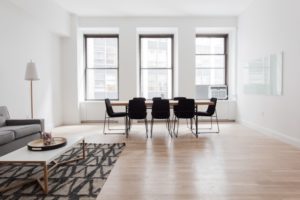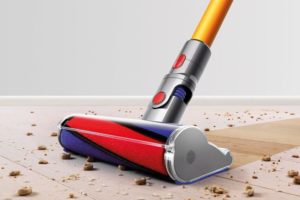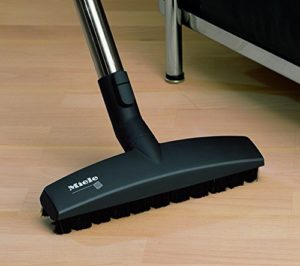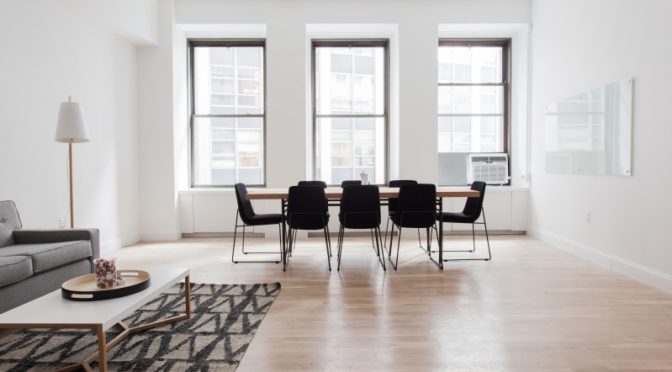
If you’re considering bare flooring over carpeting for your home but want something different from the usual options of hardwood, tile, vinyl, and laminate, you might wish to consider bamboo. Bamboo flooring resembles hardwood flooring in a number of ways even though the plant is technically a form of grass instead of a tree. Like hardwood floors, there are certain benefits and drawbacks to be aware of. Today we’ll look at the advantages, disadvantages, and practicalities of bamboo floors.
What are the advantages of choosing natural bamboo floors?

One of the primary reasons why homeowners consider bamboo floors is because they’re ecologically friendly. Bamboo flooring comes from the bamboo plant, which can grow from a seedling to harvesting age in fewer than five years. Compared to hardwood trees, which often require at least 20 years to fully mature, bamboo is a far more renewable resource.

Second, bamboo is one of the easiest floors to maintain. Unlike most bare floors that require refinishing or sealing to protect them, bamboo floors simply require regular sweeping and vacuuming to keep them neat and tidy; even a stick vacuum like the Dyson V8 Absolute can be enough to maintain a home full of bamboo flooring. You’ll also see benefits from mopping it with a damp mop occasionally, or using a bamboo floor cleanser or hardwood floor cleanser to clean it. You just need to keep away from alkaline and wax-based cleaners.
Third, bamboo has a lot of appeal among homeowners interested in stylish, trend-setting flooring options. It’s considered an elegant alternative to hardwood, and whether you’re interested in adding feng shui or simply in using natural and ecologically-friendly materials, you’re going to get style points for choosing bamboo.
Fourth, bamboo is generally no more expensive than hardwood floors, although the specific costs will naturally vary with the kind of bamboo you’re comparing to hardwood flooring. It’s best to budget somewhere between $3 and $9 for each square foot of bamboo coverage you need. Stay away from the cheapest materials, as they’re almost always going to be made from lower-grade bamboo that won’t last as long as mid- to high-grade planks.
What are the disadvantages of bamboo flooring?

That said, not all that glitters is gold. Perhaps the most significant concern associated with using bamboo as a flooring material is the potential for VOC emission. Although bamboo itself is a natural, organic material, the floor planks laid down in bamboo flooring are made by shredding bamboo stalks and gluing them together with pressure, heat, and resins.
The resins used leak volatile organic chemicals through a process known as off-gassing; this is a problem common to synthetic carpets, upholstery, and any kind of plastic or petroleum-based flooring in general. While the levels of VOCs bamboo planks emit will vary with the kind and quantity of resins used in the manufacturing process, it’s rather certain that whatever bamboo floor you install will off-gas indoors if you have it installed in new condition.

Beyond emissions, bamboo floors are also prone to scratches; this is due to the nature of the plant, which is porous and flexible to allow for rapid growth. Owners of bamboo floors inevitably make peace with the wide range of objects that can scratch their floors, from cat and dog claws to high heels to children’s toys to furniture legs. Even if you’re particularly careful to keep pets and kids away from your floors, you’ll eventually find scratches simply from bits of dirt and sand that grind into your floors like sandpaper over time.
Bamboo is particularly vulnerable to humidity changes
Aside from its susceptibility to scratches, bamboo is also vulnerable to high variations in humidity and water damage. When using bamboo in areas of high humidity, the planks may plump as they absorb moisture from the air. Conversely, if the environment is particularly dry, such as in a desert, the planks may shrink to some degree. Plumping or shrinking will lead to cracks that won’t disappear when humidity levels stabilize.
Similarly, while bamboo can tolerate water damage more than most hardwood surfaces, it’s still an organic material instead of a synthetic one. As a result, persistent exposure to low levels of water or acute exposure to high levels of water can lead to warping or mold growth. If you have a flood, say due to a broken sump pump, your flooring might be irreparably damaged.
Are bamboo floors worth the investment?
Only you can decide whether bamboo floors make sense for your home and family. If the cons above make you nervous, we’d personally suggest considering other bare flooring options with fewer vulnerabilities and longer track records, including hardwood floors, which can last for hundreds of years when properly maintained. That said, there are plenty of happy bamboo owners throughout the United States and a growing number in Canada, and if it’s a dream of yours to use bamboo flooring, you’ll find a way to make it work.
Which vacuums best maintain bamboo floors?

While you can maintain bamboo floors with just about any vacuum cleaner, we tend to recommend machines that will not only care for bamboo and other bare floors, but will also work well with carpets and area rugs. Most importantly, you’ll want vacuums that can last for decades so you aren’t constantly replacing them (and emptying your wallet and the world’s resources) every few years due to planned obsolescence.
When it comes to effectively vacuuming bamboo or other bare floors, we find vacuums with Parquet heads particularly useful, as they’ll suck up dirt and debris efficiently instead of pushing it around with their suction, which many vacuums often do bare floors. Two buy-it-for-life vacuums with Parquet heads and the flexibility to clean any kind of carpet pile and style include the Miele Complete C3 Cat & Dog (reviewed here and here) and Miele Compact C2 Electro+ (reviewed here and here). Between the two, we prefer the Cat & Dog, as it offers more cleaning options for families with pets and allergies than the Electro+, but both are excellent all-around choices.
![]() You can buy the Miele Complete C3 Cat & Dog here on Amazon or buy the Miele Compact C2 Electro+ here.
You can buy the Miele Complete C3 Cat & Dog here on Amazon or buy the Miele Compact C2 Electro+ here.
![]() Canadians can buy the Miele C3 Cat & Dog here or buy the Compact Electro+ here.
Canadians can buy the Miele C3 Cat & Dog here or buy the Compact Electro+ here.
 If you find our research on PMC helpful, you can follow our efforts to keep maniacally reviewing home cleaning tools by shopping through our links above. We promise to keep fighting the good fight against every horror children, animals, and grown, yet messy humans can inflict upon a clean home.
If you find our research on PMC helpful, you can follow our efforts to keep maniacally reviewing home cleaning tools by shopping through our links above. We promise to keep fighting the good fight against every horror children, animals, and grown, yet messy humans can inflict upon a clean home.

